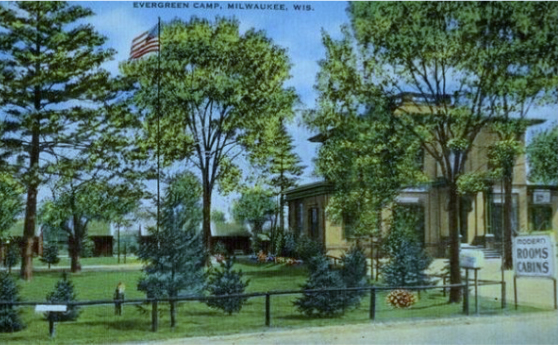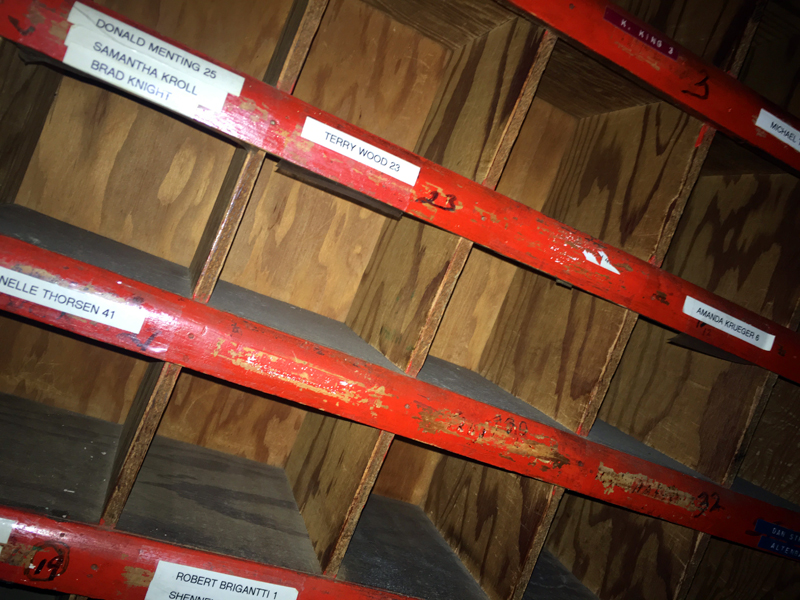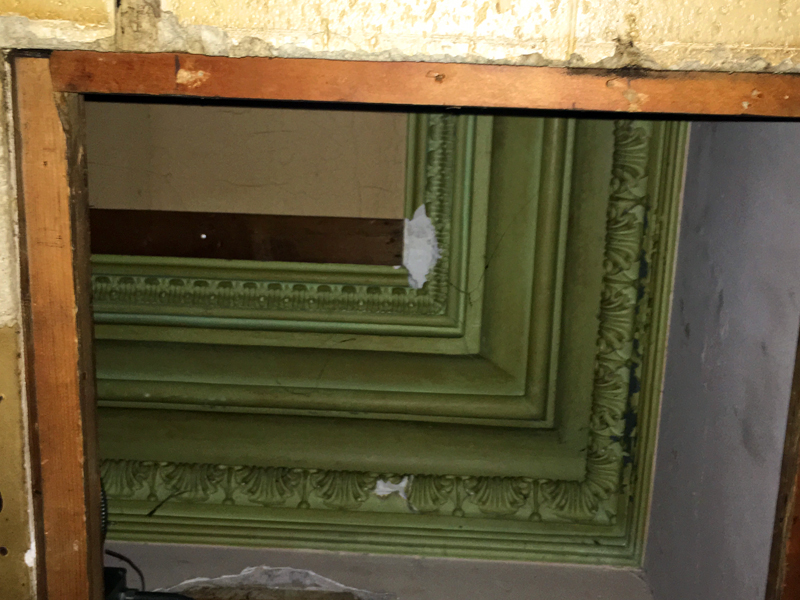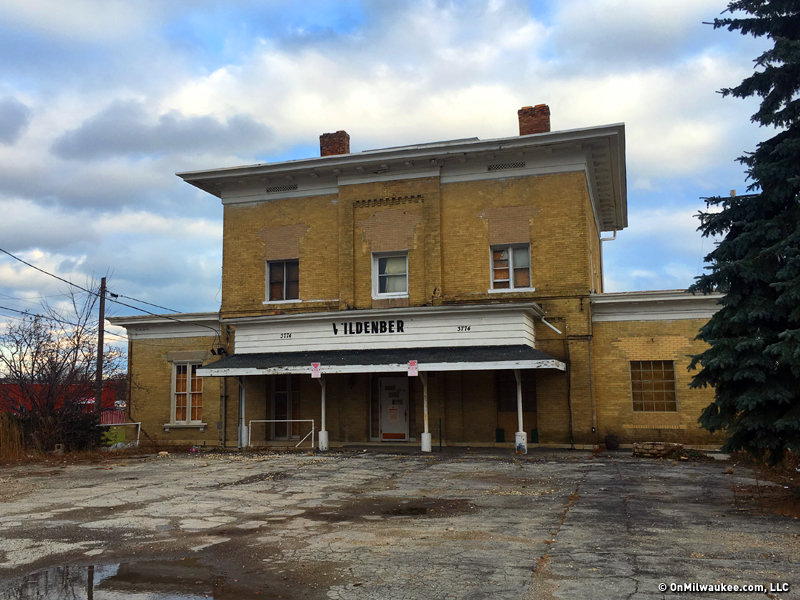UPDATE: The building was listed by the City of Milwaukee in 2024 and the new owner – Rakesh Rehan, the owner of Cafe India – has a plan to open a restaurant and events venue on the site, including in the existing building, which would get a large addition.
Based on what some folks say the Wildenberg Hotel, 3774 S. 27th St., was in pretty bad shape during its waning days in 2014. So, it comes as no surprise that the since-vacant place (currently for sale) is now in even worse condition.
But it wasn't always that way. In fact in the middle of the 19th century, the place was the manor house of an idyllic country farm.
Trained as a butcher, 23-year-old Swiss-born Jacob Nunnemacher came to Milwaukee in 1842, where he worked for others until he’d saved enough to open his own shop in the First Ward Market Hall, on the site of the current City Hall at Water and Wells.
 The distillery, as it appeared in the 1930s. (PHOTO: Courtesy Milwaukee Dept. of City Development)
The distillery, as it appeared in the 1930s. (PHOTO: Courtesy Milwaukee Dept. of City Development)
Nunnemacher lived across the street from his business, on the southwest corner of the same intersection. Later, he built a three-story brick building on the site, which would itself be replaced by the Blatz Hotel.
Nunnemacher was interested in real estate and made some investments in land. He also spent his own money and effort to fill in the channel that created a small island in the Milwaukee River. Though surely the fisherman who squatted on the island was less than thrilled, Nunnemacher’s years-long work created a little extra land Downtown – in the form of what is now called Edison Street.
In 1868, Nunnemacher bought Byron Kilbourn’s place on 4th and Wisconsin and converted it to commercial uses. By 1870, Nunnemacher’s work and investment had paid such dividends that he could afford to build a Grand Opera House across the street from his home, on the site of The Pabst Theater.
But Nunnemacher also owned suburban land. A lot of surburban land – as many as 1,400 acres by the time he died in 1876. Among that property was the land on 27th Street, which was then called Kilbourn Road, about five miles out of Downtown.

He ran a farm – growing grain and raising livestock – on the land which he purchased in 1853 and 1856 he built the structure we see today, which is the oldest in town.
He also built the Kinnickinnic Distillery on the site in 1855, which got him in trouble about a decade later when the government seized the distillery for tax fraud, though he got it back within a year. In 1874, a still exploded, causing the collapse of the roof, smokestacks and some of the walls.
He rebuilt, and the feds came back with charges of tax fraud. Nunnemacher was found guilty on one of three such charges and he was sent to the County Jail for five months and fined $10,000. However, Nunnemacher was pardoned by President Ulysses S. Grant seven weeks into his incarceration.
Nunnemacher died in 1876. But his house has survived long after. And it’s a beautiful place – you can still see.
The main part of the cream city brick building is a two-story square section with a hipped roof and wide eaves with brackets. Look closely and you can see two long, thin, elegant roof vents out front. Single story wings flank the main section, and a pair of chimneys wisp up out of the roof.

While on the first floor, some of the tall, thin Italianate windows survive (even if their shutters don’t), upstairs in the center portion all three window openings have been made shorter, lopped in half in a way that can be called anything but artful. The narrower windows around the back and sides have suffered the same poorly executed downsizing.
Around the back are a couple of additions and a rickety metal storage shed. And land. Lots of land.
Werner Trimborn bought the 120 acres after Nunnemacher’s death and operated the distillery until the 77-year-old Trimborn himself died in 1879. Soon after, his heirs again sold the place to Henry Manschot, who had bought out Nunnemacher’s stake in the original meat market.
A series of owners followed: Milwaukee Rendering Company, F. F. Reidel, Walter Stenz, Bridge Czerwinski and her daughter Louise Nalence. In 1932, during the latter’s tenure, a newspaper article reports that the distillery and the dining hall were still standing, but not the four cattle barns.
 (PHOTO: Courtesy Milwaukee Dept. of City Development)
(PHOTO: Courtesy Milwaukee Dept. of City Development)
Though it’s not certain, Bridget Czerwinski and her husband Lewis may have built the series of log cabins on the north side of the property that operated as the Evergreen Camp, an early motel on Highway 41 (aka 27th Street).
But it was under the ownership of Edward J. Vanden Wildenberg, who bought the place in 1954, that the motel business got its most recognizable name. The cabins were apparently sold and taken away and Wildenberg ran the place as a trailer park. They also rented rooms in the house and continued to run the bar that had been in the north parlor on the first floor during the Czerwinski era.

Later, the bar would be moved across the hall to the south side of the building. But business got hard, according to Diane Klug, whose mother Eleonore Wildenberg-Klug owned the place when OnMilwaukee’s Molly Snyder talked to her.
"People can't get off on 27th Street anymore. Business is so slow, you could throw a bowling ball down the middle of this place without hitting anyone," said Klug, about how freeway reconstruction was affecting business at the Wildenberg, where five available rooms rented for $50 to $100 a week.

Klug told OnMilwaukee that the bar used to draw business, too, including folks waiting for repairs to be made on their vehicles at one of the nearby auto shops and men waiting for their wives or partners to shop at one of the stores on 27th Street.
"That doesn't happen anymore," Klug said. "Not since (back when) the ramp was open."
In 2013, the city acquired the property on a tax deed. The more than 30 trailers are gone and all that survives on the land is the original house and that little shed.
Inside and out, the house is in rough shape. The Department of City Development has it listed at $815,000 – a large plot of land on 27th Street is pretty valuable – but you could surely deal if you had a good idea. DCD tells me they’d love to see the building survive.

There’s some incredible potential here, because the house – architect unknown – is a stunner. Outside, hidden beneath that hideous late-era porch is a gorgeous, regal arched doorway that retains its "Evergreen" fanlight.
Inside, there’s a grand hallway leading straight back from the main entrance. The hardwood floors are beautiful and the staircase leading to the second floor is imposingly grand, with a newel post that you’d need a tractor to move.

A number of the rooms have original marble fireplaces that look indestructible, though someone attempted to take one of them away when the city got the property, proving that it is possible to destroy these. However, the city had the pieces returned in hopes that it can be restored.

The bar is still there, too, and its fireplace has a grapevine motif. Above the bar are some antique hanging lights. A section of the awful dropped ceiling has been removed to reveal another couple feet of ceiling height and elaborate ornamental plaster moldings.
Interestingly, the stairs up to the attic are about as grand as the ones between the first and second floor. Perhaps the attic, which is spacious, was planned with expansion in mind. Up here it’s easy to see the construction of the house – lots of square nails to be found – and to get up close to those long, narrow vent openings.
The second floor and basement are full of smaller rooms, each and every one of them full of junk. Buy the place and the first thing you’ll need is some dumpsters.
But, beneath all the trash is a real Milwaukee landmark, and a gorgeous Italianate cream city brick home that is deeply rooted in Brew City history.
Born in Brooklyn, N.Y., where he lived until he was 17, Bobby received his BA-Mass Communications from UWM in 1989 and has lived in Walker's Point, Bay View, Enderis Park, South Milwaukee and on the East Side.
He has published three non-fiction books in Italy – including one about an event in Milwaukee history, which was published in the U.S. in autumn 2010. Four more books, all about Milwaukee, have been published by The History Press.
With his most recent band, The Yell Leaders, Bobby released four LPs and had a songs featured in episodes of TV's "Party of Five" and "Dawson's Creek," and films in Japan, South America and the U.S. The Yell Leaders were named the best unsigned band in their region by VH-1 as part of its Rock Across America 1998 Tour. Most recently, the band contributed tracks to a UK vinyl/CD tribute to the Redskins and collaborated on a track with Italian novelist Enrico Remmert.
He's produced three installments of the "OMCD" series of local music compilations for OnMilwaukee.com and in 2007 produced a CD of Italian music and poetry.
In 2005, he was awarded the City of Asti's (Italy) Journalism Prize for his work focusing on that area. He has also won awards from the Milwaukee Press Club.
He has be heard on 88Nine Radio Milwaukee talking about his "Urban Spelunking" series of stories, in that station's most popular podcast.







